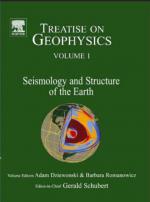Добрый день, Коллеги. Важное сообщение, просьба принять участие. Музей Ферсмана ищет помощь для реставрационных работ в помещении. Подробности по ссылке
Treatise on geophisics. Mantle Dynamics. Volume 7/ Трактат о геофизике. Динамика мантии. Том 7.
Much of what we refer to as geology, or more accurately geological activity on Earth, is due to the simple act of our planet cooling to space. What allows this activity to persist over the lifetime of the solar system is that the major and most massive portion of the planet, namely the mantle, is so large, moves so slowly, and cools so gradually that it sets the pace of cooling for the whole Earth. If the Earth’s other components, such as the crust and core, were allowed to lose heat on their own, their small size or facile motion would have allowed them to cool rapidly and their activity would have ceased eons ago. For this reason, the study of the dynamics of the mantle, both its evolution and circulation, is critical to our understanding of how the entire planet functions. Processes from plate tectonics and crustal evolution to core freezing and hence the geodynamo are governed, and in many ways driven, by the cooling of the mantle and the attendant phenomenon of mantle convection, wherein hot buoyant material rises and cold heavy material sinks. To some extent the development of the field of mantle dynamics is most closely linked with the history of theories of continental drift and plate tectonics. Although mantle convection was invoked to provide a driving mechanism for continental (or plate) motions, the hypothesis that the mantle flows and circulates predates even that of continental drift (see Schubert et al., 2001, chapter 1). As discussed recently by England et al. (2007), John Perry used the notion of mantle convection in 1895 to refute the estimate for the age of the Earth given by his former mentor William Thomson (Lord Kelvin). However, a great deal of progress on understanding mantle convection also comes, obviously, from the general study of the physics of thermal convection, not specifically applied to the mantle. Histories of plate tectonics (or continental drift) are in abundance (e.g., Menard, 1986; Hallam, 1987) and the recent text on mantle dynamics by Schubert et al. (2001) gives an excellent summary of the history of the development of mantle convection theory in conjunction with plate tectonics. However, the historical context and personalities associated with some of the steps in this development are important to understand in terms of how the field evolved, and to some extent how science in general has been done and is done now. Thus, rather than merely repeat other historical summaries here, we will focus instead on the contributions (pertaining primarily to mantle convection) and professional and personal histories of some of the leading names in the development of the theories of thermal convection and mantle dynamics. Roughly keeping with the structure of this volume, this section concentrates on the origins of the physics, theory, and systematic experiments of convection by visiting Benjamin Thompson (Count Rumford), John William Strutt (Lord Rayleigh), and Henri Claude Be´nard. This will be followed by reviewing the lives of some of the pioneers of the quantitative analysis of mantle convection as a driving force of ‘continental drift’ namely Arthur Holmes, Anton Hales, and Chaim Pekeris, and then two leading proponents of convection and its association with the modern theory of seafloor spreading, subduction, and plate tectonics, Harry Hammond Hess and Stanley Keith Runcorn.




